This was published 2 years ago
‘Without Jo there would have been no van Gogh’
The celebrated artist’s sister-in-law is finally being hailed as the person who brought his art to the world.
By Russell Shorto
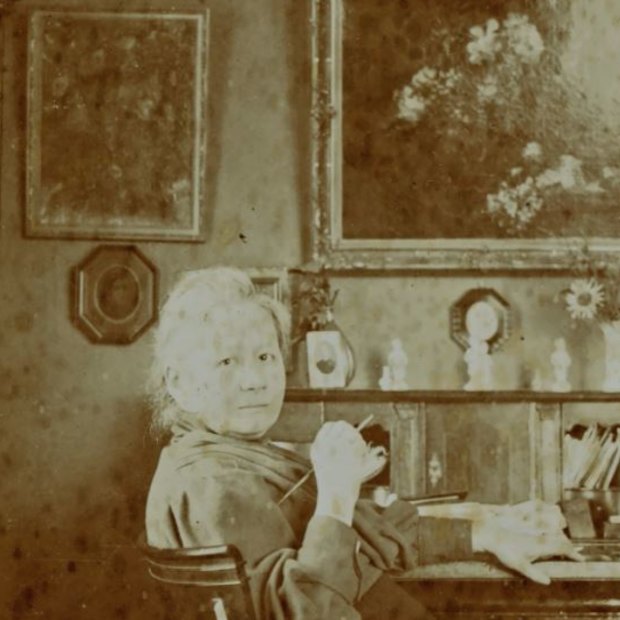
Johanna van Gogh-Bonger became a tireless advocate for Vincent van Gogh’s work after her husband Theo’s death in 1891. On the wall of her living room, circa 1909, are Henri Fantin-Latour’s Flowers and Vincent van Gogh’s Vase of Honesty (1884).Credit: Unknown photographer, Van Gogh Museum, Amsterdam (Vincent Van Gogh Foundation)
In 1885, a 22-year-old Dutch woman named Johanna Bonger met Theo van Gogh, the younger brother of the artist, who was then making a name for himself as an art dealer in Paris. History knows Theo as the steadier of the van Gogh brothers, the archetypal emotional anchor, who selflessly managed Vincent’s erratic path through life, but he had his share of impetuosity. He asked her to marry him after only two meetings.
Jo, as she called herself, was raised in a sober, middle-class family. Her father imposed a code of propriety and emotional aloofness on his children. Jo had set herself up in an unexciting career as an English teacher in Amsterdam. She wasn’t inclined to impulsiveness. She said no.
But Theo persisted. He was attractive in a soulful kind of way and eventually won her over. In 1888, a year-and-a-half after his proposal, she agreed to marry him. After that, a new life opened up for her. It was Paris in the belle époque: art, theatre, intellectuals. Theo was not just any art dealer. He was at the forefront, specialising in the breed of artists who were defying the realism imposed by the Académie des Beaux-Arts. Most dealers wouldn’t touch the Impressionists, but they were Theo van Gogh’s clients and heroes.
Theo talked incessantly – of the future, and also of things like pigment and colour and light. But one subject dominated. From their first meeting, he regaled Jo with accounts of his brother’s tortured genius.
Their apartment was crammed with Vincent’s paintings. Vincent, who spent much of his career in motion, in France, Belgium, England, the Netherlands, was churning out canvases at a fanatical pace – olive trees, wheat fields, peasants under a Provençal sun – and shipping them to Theo in hopes he would find a market for them. When, a little more than nine months after their wedding, Jo gave birth to a son, she agreed to name the boy Vincent.
As much as he looked up to his brother, Theo fretted constantly about him. Vincent’s mental state had already deteriorated by the time Jo came on the scene. Just before Christmas in 1888, Vincent was in Arles cutting off his ear following a series of rows with Paul Gauguin.
One day a canvas arrived that showed a shift in style. Vincent had been fascinated by the night sky in Arles. He tried to put it into words for Theo: “In the blue depth the stars were sparkling, greenish, yellow, white, pink, more brilliant, more emeralds, lapis lazuli, rubies, sapphires.” He became fixated on the idea of painting such a sky.
Vincent sent the finished painting to Theo and Jo with a note explaining that it was an “exaggeration”. The Starry Night continued his progression away from realism; the brush strokes were like troughs made by someone who was digging for something deeper. Theo found it disturbing: he could sense his brother drifting away, and he knew buyers weren’t likely to understand it. He wrote back, “I consider that you’re strongest when you’re doing real things.”
Then, in the spring of 1890, news: Vincent was coming to Paris. Jo expected an enfeebled mental patient. Instead, she was confronted by the physical embodiment of the spirit that animated the canvases that covered their walls. “Before me was a sturdy, broad-shouldered man with a healthy colour, a cheerful look in his eyes and something very resolute in his appearance,” she wrote in her journal.
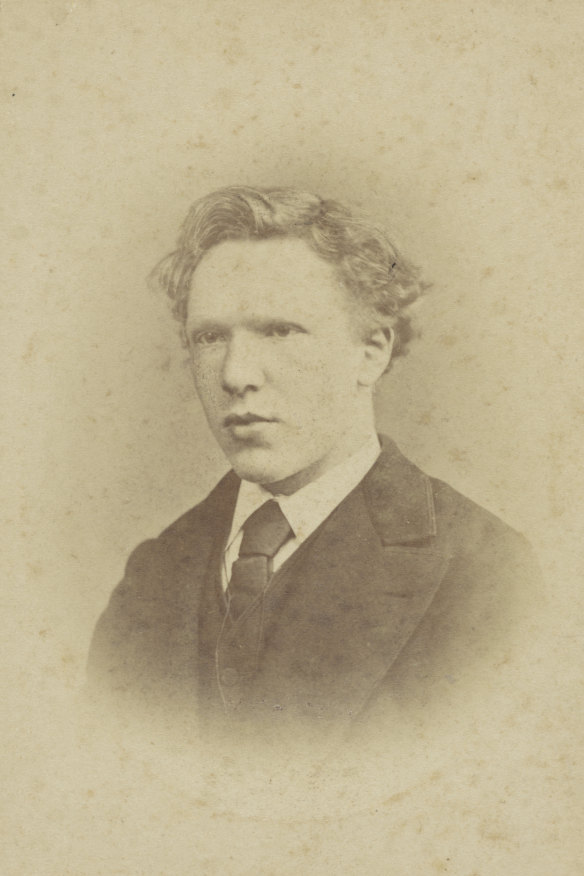
The only known photo of Vincent, aged 19.Credit: Jacobus Marinus Wilhelmus de Louw. Courtesy of the Van Gogh Museum, Amsterdam (Vincent van Gogh Foundation)
What happened next was like two blows of a hammer. Theo had arranged for Vincent to stay in the village of Auvers-sur-Oise to the north of Paris, in the care of Dr Paul Gachet. Weeks later came news that Vincent had shot himself. Theo arrived in the village in time to watch his brother die.
Theo was devastated. Less than three months after Vincent’s death, he suffered a complete physical collapse, the latter stages of syphilis he had contracted from earlier visits to brothels. His agony was tremendous and ghoulish. He died in January 1891.
The brothers dying so young – Vincent at 37 and Theo at 33 – could have ensured that Vincent van Gogh’s work would subsist eternally in obscurity. Instead, his name, art and story merged to form the basis of an industry that stormed the globe. That happened in large part thanks to Jo van Gogh-Bonger, whose full story has only recently been uncovered. It is only now that we know how van Gogh became van Gogh.
Long before COVID-19, Hans Luijten was in the habit of likening Vincent van Gogh to a virus. “If that virus comes into your life, it never goes away,” he said when we first spoke in 2020. Luijten is 60, with wire-rimmed glasses and floating tufts of gray hair. He majored in Dutch literature and minored in art history. After getting his doctorate, he heard that the Van Gogh Museum in Amsterdam wanted to develop a new critical edition of the 902 letters in the Vincent van Gogh correspondence, including those that he and Theo exchanged. In 1994 he was hired as a researcher and spent the next 15 years on that work.
The end result is Vincent van Gogh: The Letters. It runs to six volumes and more than 2000 pages and was published in 2009. Leo Jansen, who toiled alongside Luijten for those 15 years and now works at the Huygens Institute for the History of the Netherlands, told me that as they neared the end of the van Gogh project, he sensed that Luijten was beginning to formulate a new idea. “I think Hans realised that, while we were at last delivering Vincent’s letters, that project was only just a start, because Vincent wasn’t even known at the end of his life.”
“I started to see that [Jo] was the spider in the web. She had a strategy.”
Which raised a question that had never been completely answered: how exactly did the tortured genius become one of the most beloved figures in the history of art?
Jo van Gogh-Bonger was previously known to have played a modest role in building the painter’s reputation. Still, there were intriguing indications for those interested enough to look. Luijten searched the museum’s library and archives and found photographs and account books. He corresponded with archives in France, Denmark and the United States. He began to formulate a thesis: “I started to see that she was the spider in the web. She had a strategy.”
There was another source, which he believed might advance his thesis. Luijten knew Jo had kept a diary. His interest was piqued in part by the very fact that he hadn’t been able to read it: the van Gogh family had kept it under lock and key since her death in 1925. The diary remained under embargo until, in 2009, Luijten asked Jo’s grandson, Johan van Gogh, if he could see it, and Johan granted his wish.
In 2009 Luijten began writing a biography of Jo; it took him 10 years. The book, Alles voor Vincent (All for Vincent), was published in 2019. Because it’s still available only in Dutch, it is just beginning to percolate into the world of art scholarship.
“It’s massively important,” says Steven Naifeh, co-author of the bestselling 2011 biography Van Gogh: The Life and author of the forthcoming Van Gogh and the Artists He Loved.
“It shows that without Jo there would have been no van Gogh.”
Art historians say Luijten’s biography is a major step in what will be an ongoing reappraisal – not only of the source of van Gogh’s fame but also of the modern notion of what an artist is. For that, too, is something Jo helped to invent.
Jo was at a loss after Theo died. When a friend from the Dutch village of Bussum suggested she come there and open a boarding house, it seemed soothing. Bussum had a lively cultural scene, and with income from guests she would be able to provide for herself and her child.
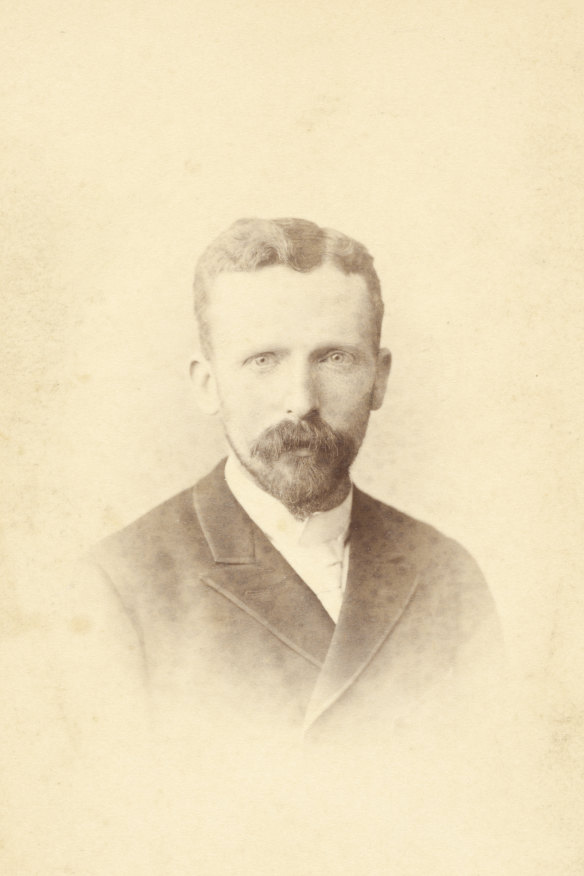
Theo van Gogh, art dealer and younger brother of Vincent.Credit: Courtesy of the Van Gogh Museum, Amsterdam (Vincent van Gogh Foundation)
Before leaving Paris, she corresponded with the artist Émile Bernard, to see if he might be able to arrange an exhibition in Paris of her late brother-in-law’s paintings. Bernard urged her to leave Vincent’s canvases in Paris, reasoning that the French capital was a better base from which to sell them. Had that happened, Vincent might have developed some renown. But Jo’s instincts told her to keep the paintings with her. She declined his offer.
Over the next weeks, she settled into her new home. She seems to have spent the greatest amount of her time deciding precisely where to hang her brother-in-law’s paintings. Eventually, virtually every inch of wall space was covered with them.
Then, she returned to her diary, which she had begun in her teens. She had set it aside the moment she started her life with Theo; now she was back. In it, she identified the two responsibilities that Theo had given her.
“As well as the child,” she wrote, “he has left me another task – Vincent’s work – getting it seen and appreciated as much as possible.”
In addition to Vincent’s paintings, she had inherited the enormous trove of letters that the brothers had exchanged. In Bussum, she pored over them. Nearly all, it turned out, were from Vincent, which her husband had carefully kept. Details of the artist’s daily life and tribulations – his insomnia, his poverty, his self-doubt – were mixed with accounts of paintings he was working on, techniques he experimented with, descriptions of paintings by other artists he drew inspiration from. She did a lot of other reading as well, undertaking what amounted to a self-guided course in art criticism.
“As well as the child, he has left me another task – Vincent’s work – getting it seen and appreciated as much as possible.”
By the end of her first year on her own, Jo had experienced a kind of epiphany: Van Gogh’s letters were part and parcel of the art. They were keys to the paintings. The letters brought the art and the tragic, intensely lived life together into a single package.
The letters also pointed to the audience Vincent had intended. Vincent had desperately wanted to make art that reached directly into the hearts of common people. “No result of my work would be more agreeable to me,” he wrote to Theo, quoting another artist, “than that ordinary working men should hang such prints in their room or workplace.”
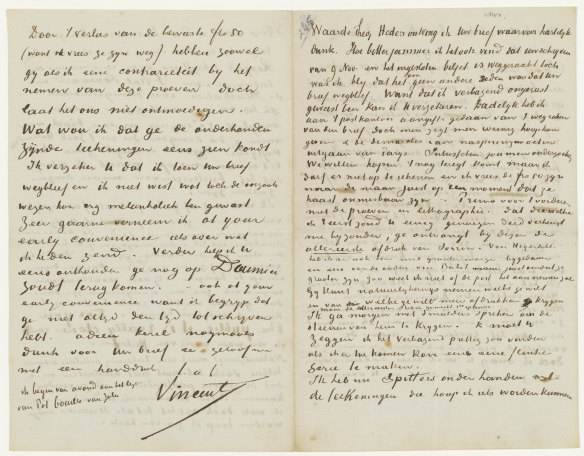
Johanna van Gogh-Bonger thought the letters between her husband and brother-in-law were key to understanding Vincent’s art.Credit: Courtesy of the Van Gogh Museum, Amsterdam (Vincent van Gogh Foundation)
Vincent’s letters and paintings seemed to reinforce Jo’s own long-standing convictions about social justice. Just before agreeing to marry Theo, she visited Belgium, and the minister whose family she was staying with took her to see the conditions of workers at a coal mine. The experience helped fuel a lifelong dedication to causes ranging from workers’ rights to female suffrage. She counted herself as one of the “ordinary” people Vincent had written of, and she knew that he had considered himself one as well.
One of Jo’s first moves was to approach an art critic named Jan Veth, who was outspoken in his rejection of academic art. At first, though, Veth dismissed Vincent’s work outright and belittled Jo’s efforts. He himself later admitted that he was initially “repelled by the raw violence of some van Goghs”.
Jo found Veth’s reaction disappointingly conventional. But she realised his importance as a critic and believed that his openness to new ideas meant that she could persuade him to appreciate the paintings, telling her diary, “I won’t rest until he likes them.”
She pressed an envelope full of Vincent’s letters on Veth, encouraging him to use them as a means to illuminate the paintings. Her timing was good. The Dutch historian Johan Huizinga later characterised the “change of spirit that began to be felt in art and literature around 1890” as a swirl of ideas that coalesced around two poles: “that of socialism and that of mysticism”. Jo saw that Vincent’s art straddled both.
Veth was among those trying to process a shift from Impressionism to something new, an art that applied individualism to social and even spiritual questions. He listened to Jo and came around. He wrote one of the first appreciations of the artist, saying he now saw “the astonishing clairvoyance of great humility” and characterised Vincent as an artist who “seeks the raw root of things”.
Jo worked doggedly to build on her early success. She did much else in her life, of course. She raised her son. She fell in love with the painter Isaac Israëls, then broke it off when she realised he was not interested in marriage. She remarried: yet another Dutch painter, Johan Cohen Gosschalk. She became a member of the Dutch Social Democratic Workers’ Party and a co-founder of an organisation devoted to labour and women’s rights. But all these activities were woven around the task of managing her brother-in-law’s postmortem career.
Her training as a language teacher – she knew French, German and English – came in handy as she expanded her reach, attracting the interest of galleries and museums in Berlin, Paris, Copenhagen. In 1895, the Parisian dealer Ambroise Vollard included 20 van Goghs in a show; in Antwerp, a group of young artists who saw van Gogh as a trailblazer asked to borrow several paintings to exhibit alongside their own work.
In 1905, she arranged a major exhibition at the Stedelijk Museum, Amsterdam’s premier modern-art showcase. The success she had had in promoting her brother-in-law’s art boosted her self-confidence.
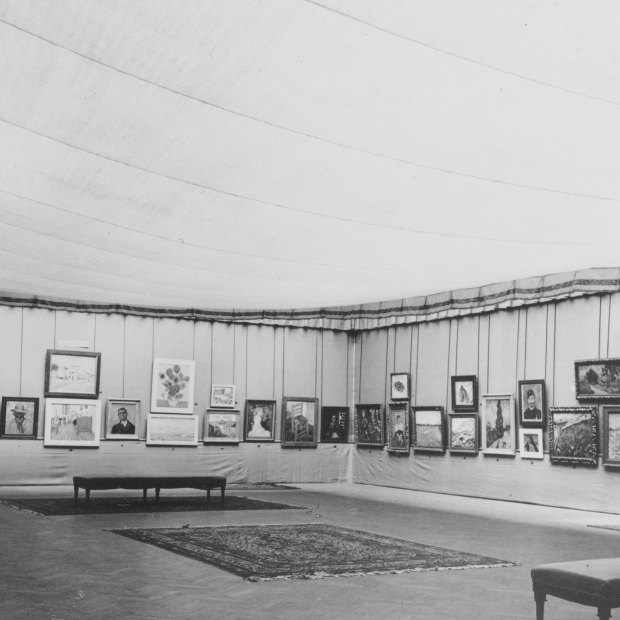
Jo pushed for major showings of Vincent’s work, such as at the “Kunst van heden” exhibition in Antwerp, 1914.Credit: Van Gogh Museum Documentation, Amsterdam
She rented the galleries, printed the posters, assembled names of important people to invite, even bought bow ties for the staff. The result was, and remains, the largest-ever van Gogh exhibition, with 484 works on display. Critics came from all over Europe. The event cemented the artist’s reputation as a major figure of the modern era.
There was one caveat. The work of Vincent’s later period, when he was in an asylum in the south of France and after, which today is probably the most beloved part of his oeuvre, made some people uncomfortable. To some critics, these paintings seemed clearly the product of mental illness.
The Starry Night, in particular, was singled out for criticism. The discomfort over its distortions began with Theo, and Jo may have initially shared her
husband’s uneasiness toward it. She didn’t include it in any of the early exhibitions and eventually sold it. But she then got the owner of the painting to lend it for the Amsterdam show, suggesting that she had come to embrace its intensity.
One reviewer attacked The Starry Night, likening the stars in the painting to oliebollen, the fried dough balls that Dutch people eat on New Year’s Eve. That kind of criticism only seemed to bring more attention to the painting, and ultimately to give further validity to the idea of art as a window into the mind of the artist. It eventually ended up at the Museum of Modern Art, becoming the first van Gogh in the collection of a New York museum.
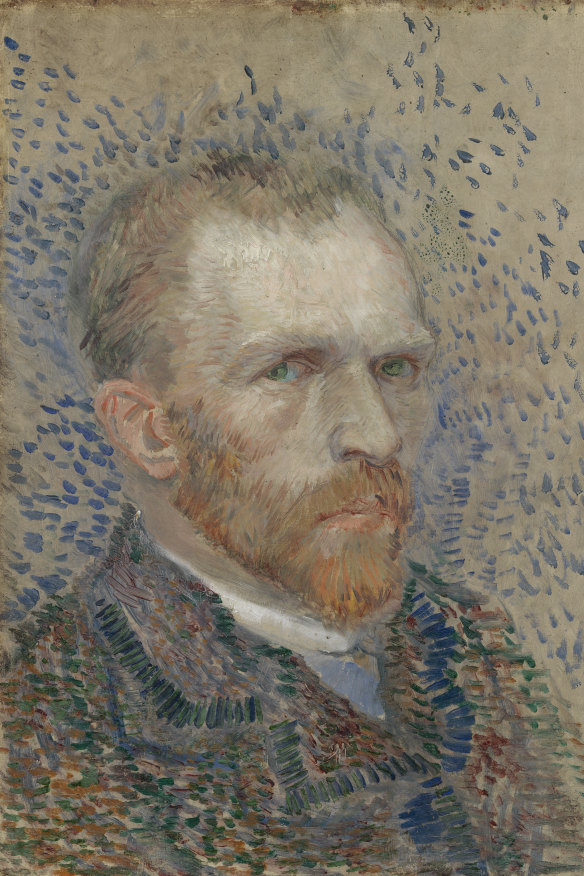
A Vincent van Gogh self-portrait.Credit: Vincent van Gogh, Self-Portrait, March-June 1887, oil on cardboard, 41 x 33cm. Courtesy of the Van Gogh Museum, Amsterdam (Vincent van Gogh Foundation)
In 1916, at age 54, Jo confronted the most formidable challenge in her campaign to bring Vincent to the world. For all the success she had had in Europe, the United States, with its conservative and puritanical society, lagged in appreciating the artist. She left Europe and moved to New York with a goal of changing that.
She found it tough going at first. But change came. She eventually arranged a show with Montross’s gallery on Fifth Avenue. Shortly after, the Metropolitan Museum featured an exhibition of Impressionist and Post-Impressionist Paintings, to which Jo contributed four canvases.
Jo continued to believe that the letters to Theo would open up his soul to the US and beyond. Having the letters published in English was her last great objective. It proved to be a race against time. Her health was failing – she had Parkinson’s disease – and the publisher she had contracted with, Alfred Knopf, wanted to produce only an abridged edition, to which she would not agree. She returned to Europe and lived her last years in an apartment in Amsterdam and in a country house in Laren.
She kept remarkably fixated on her life’s mission: shipping canvases to one exhibition after another, wrangling with the publisher, all the while coping with her illness. She died in 1925 at age 63.
The first English-language edition of the letters appeared in 1927. It contained an introduction by Jo, in which she highlighted her husband’s role: “It was always Theo alone who understood him and supported him.” Seven years later, Irving Stone published his bestselling novel Lust for Life, about the relationship between the van Gogh brothers. It, in turn, became the source material for the 1956 film starring Kirk Douglas.
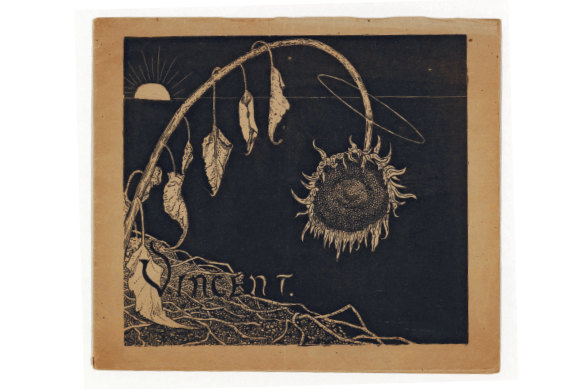
The cover of an 1892 Van Gogh exhibition catalogue in Amsterdam.Credit: Courtesy of the Van Gogh Museum, Amsterdam (Vincent van Gogh Foundation)
There was one other homage Jo paid to her brother-in-law and her husband. Late in her life, she arranged to have Theo’s remains disinterred from the Dutch cemetery where he had been laid to rest and reburied in Auvers-sur-Oise, next to Vincent. She undertook the operation like a general, overseeing every detail, down to commissioning matching gravestones.
A wife’s digging up her husband’s remains is such a startling image it yanks one back to the central question of Jo’s life: her motivation. Why, finally, did she fasten herself to this cause and carry it across the length of her life?
Certainly her belief in Vincent’s genius and her desire to honour Theo’s wishes were strong. And Luijten noted to me that in promoting van Gogh’s art, she believed she was also furthering her socialistic political beliefs.
But people act from smaller, simpler motivations as well. Jo’s 21 months with Theo were the most intense of her life. She experienced Paris, joy, a revolution in colour and culture. With Theo’s help she vaulted out of her careful, conventional world and gave herself over to passion. Moving today through the museum that houses all the paintings Jo couldn’t bear to part with, another notion surfaces: that, in devoting herself utterly to Vincent van Gogh, in selling him to the world, she was keeping alive that moment of her youth, and allowing the rest of us to feel it.
Edited version of a story first published in The New York Times Magazine. © 2021 The New York Times Company
To read more from Good Weekend magazine, visit our page at The Sydney Morning Herald, The Age and Brisbane Times.